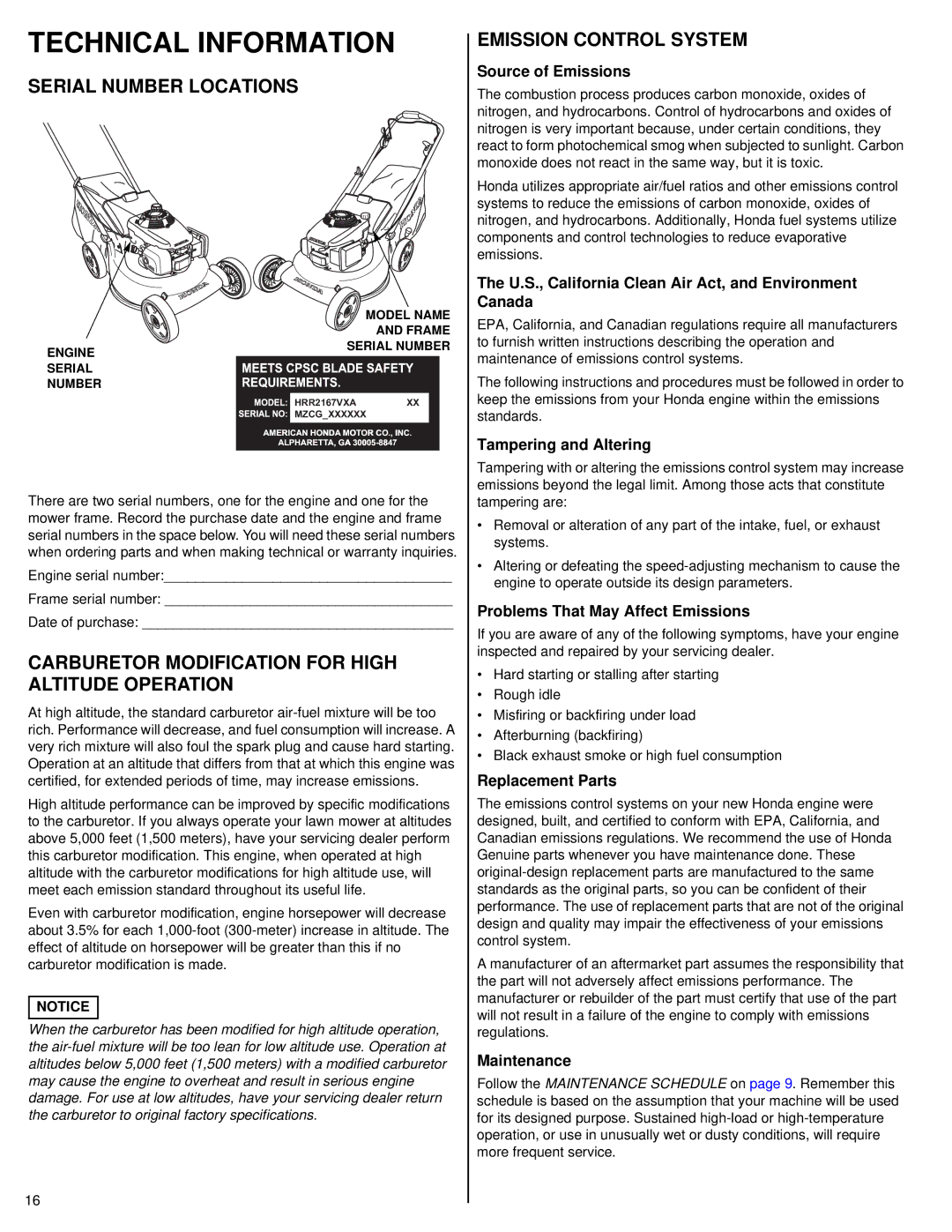
TECHNICAL INFORMATION
SERIAL NUMBER LOCATIONS
|
| MODEL NAME |
|
| AND FRAME |
ENGINE | SERIAL NUMBER | |
|
| |
SERIAL |
|
|
NUMBER |
|
|
| HRR2167VXA | XX |
| MZCG_XXXXXX | |
| AMERICAN HONDA MOTOR CO., INC. | |
| ALPHARETTA, GA | |
There are two serial numbers, one for the engine and one for the mower frame. Record the purchase date and the engine and frame serial numbers in the space below. You will need these serial numbers when ordering parts and when making technical or warranty inquiries.
Engine serial number:_____________________________________
Frame serial number: _____________________________________
Date of purchase: ________________________________________
CARBURETOR MODIFICATION FOR HIGH ALTITUDE OPERATION
At high altitude, the standard carburetor
High altitude performance can be improved by specific modifications to the carburetor. If you always operate your lawn mower at altitudes above 5,000 feet (1,500 meters), have your servicing dealer perform this carburetor modification. This engine, when operated at high altitude with the carburetor modifications for high altitude use, will meet each emission standard throughout its useful life.
Even with carburetor modification, engine horsepower will decrease about 3.5% for each
NOTICE
When the carburetor has been modified for high altitude operation, the
16
EMISSION CONTROL SYSTEM
Source of Emissions
The combustion process produces carbon monoxide, oxides of nitrogen, and hydrocarbons. Control of hydrocarbons and oxides of nitrogen is very important because, under certain conditions, they react to form photochemical smog when subjected to sunlight. Carbon monoxide does not react in the same way, but it is toxic.
Honda utilizes appropriate air/fuel ratios and other emissions control systems to reduce the emissions of carbon monoxide, oxides of nitrogen, and hydrocarbons. Additionally, Honda fuel systems utilize components and control technologies to reduce evaporative emissions.
The U.S., California Clean Air Act, and Environment Canada
EPA, California, and Canadian regulations require all manufacturers to furnish written instructions describing the operation and maintenance of emissions control systems.
The following instructions and procedures must be followed in order to keep the emissions from your Honda engine within the emissions standards.
Tampering and Altering
Tampering with or altering the emissions control system may increase emissions beyond the legal limit. Among those acts that constitute tampering are:
•Removal or alteration of any part of the intake, fuel, or exhaust systems.
•Altering or defeating the
Problems That May Affect Emissions
If you are aware of any of the following symptoms, have your engine inspected and repaired by your servicing dealer.
•Hard starting or stalling after starting
•Rough idle
•Misfiring or backfiring under load
•Afterburning (backfiring)
•Black exhaust smoke or high fuel consumption
Replacement Parts
The emissions control systems on your new Honda engine were designed, built, and certified to conform with EPA, California, and Canadian emissions regulations. We recommend the use of Honda Genuine parts whenever you have maintenance done. These
A manufacturer of an aftermarket part assumes the responsibility that the part will not adversely affect emissions performance. The manufacturer or rebuilder of the part must certify that use of the part will not result in a failure of the engine to comply with emissions regulations.
Maintenance
Follow the MAINTENANCE SCHEDULE on page 9. Remember this schedule is based on the assumption that your machine will be used for its designed purpose. Sustained
